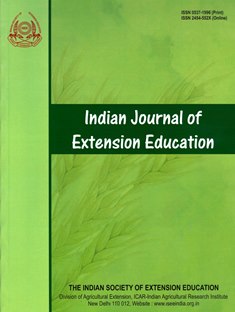Content Analysis and Coverage of News on Pandemic COVID-19 in Elected Newspapers
DOI:
https://doi.org/10.48165/IJEE.2023.59124Keywords:
Newspapers, Pandemic COVID-19, Content analysisAbstract
Newspapers have a significant impact on quality of life. Individuals are heavily influenced by the newspaper and it aids in promoting social awareness among them. This study was conducted to examine the content during pandemic COVID-19 in three selected newspapers viz., The Hindu, The Tribune and Punjab Kesari. A quantitative and qualitative analysis of the selected newspaper over the chosen time period was conducted during 2022. The majority of topics were covered in news format in all the newspapers. Newspaper correspondents were the primary information source in all the newspapers. The Hindu took up the most space and items. In all of the newspapers, the majority of the items and space were covered during PHASE-II.
Downloads
References
Khan, A., & Goel, R. (2017). Content analysis and reading behaviour towards “swachh bharat mission”. M.Sc. Thesis. CCS Haryana Agricultural University, Hisar, India.
Kobba, F., Nain, M. S., Singh, R., & Mishra, J. R. (2019). Content analysis of training module for entrepreneurship development and self-employment training institute (RUDSETI). Journal of Community Mobilization and Sustainable Development, 14(3), 538-542.
Krawczyk, K., Chelkowski, T., Laydon, D. J., Mishra, S., Xifara, D., Gibert, B., Flaxman, S., Mellan, T., Schwämmle, V., Röttger, R., Hadsund, J. T., & Bhatt, S. (2021). Quantifying online news media coverage of the covid-19 pandemic: text mining study and resource. Journal of Medical Indian Research, 23(6), 56- 93.
Mahima, B. N., Tiwari, H. K., Mahapatra, H., Amudhan, S., & Girish N. (2020). COVID-19 epidemiology: Through the eyes of vernacular newspapers. Indian Journal of Public Health, 64(6), 217-220.
Monika (2015). A study on students’ perception towards advertisements in newspapers. International Journal of Enhances Research Education Development, 3(2), 45-47.
Nain, M. S., & Trikha, R. N. (2001). Analysis of content and coverage of farm information by the farm magazine “Haryana Kheti”. Crop Research, 22(1), 129-133.
Nain, M. S., Singh, R., Sharma, J. P., & Mishra, J. R. (2019). Filling the information gap through developing and validating entrepreneurial technical information packages (ETIPs)for potential agricultural entrepreneurs. Journal of Community Mobilization and Sustainable Development,14(1), 44-48.
Raj, A., Anjali, R., & Goswami, M. P. (2020). Migrants, miseries, and media: measuring the prominence of the miseries of migrants in the coverage of leading Indian English dailies during COVID 19. Media Asia, 48(1), 5-20.
Sondarva, Y. M., Nain, M. S., & Kishan, K. (2019). Content analysis of the Gujarat Journal of Extension Education. Journal of Global Communication, 12(2), 93-96.
Weber, R. P. (1990). Basic content analysis. Beverly Hills, CA: Sage Publication.
Yale, L., & Gilly, M. C. (1988). Trends in advertising research: A look at the content of marketing- oriented journals from 1976 to 1985. Journal of Advertising, 17(1), 12-22.
Zafri, N. M., Afroj, S., Nafi, I. M., & Hasan, M. M. U. (2021). A content analysis of newspaper coverage of COVID-19 pandemic for developing a pandemic management framework. Heliyon, 7(3), 1-11.
Downloads
Published
Issue
Section
License

This work is licensed under a Creative Commons Attribution-NonCommercial-NoDerivatives 4.0 International License.

